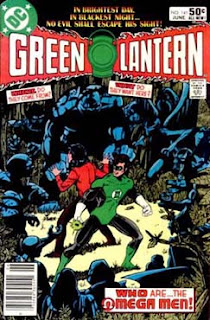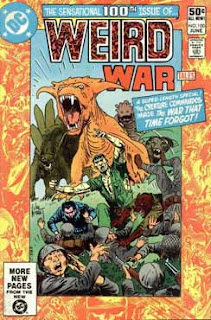I'm reading DC Comics' output from January 1980 (cover date) to Crisis! I'm a couple of days later than my usual Wednesday post, but I'm looking at the comics at newsstands on the week of March 5, 1981.
Batman #336: After Wolfman's lackluster al Ghul arc, Rozakis/Thomas bring us a much better done-in-one story with Garcia-Lopez art to sweeten the deal. The obscure 60s villain, the
Monarch of Menace, has convinced various C-grade Gotham criminals (several other minor characters from over the years) that he has captured Batman and they should pay him to keep the Caped Crusader locked up. Batman, as we know, has only been out of the country, and now that he's back he starts taking these mooks down, including the Monarch. This reminded me a bit of Mike Barr/Alan Davis run on
Detective after
Crisis, which I liked a lot.

DC Comics Presents #34: The Superman/Marvel Family team-up continues, and in true Roy Thomas fashion we even get obscure Marvel family members like Uncle Marvel and Hoppy the Marvel Bunny. No Hilly-billy Marvel, though. Buckler/Giordano might not be the go-to team for the Marvel Family, but they make it work. The team-up of Mxyzptlk, Mr. Mind, and King Kull have managed to take out the wizard Shazam and make King Kull more powerful than all the Marvels and Superman, but their alliance crumbles when the other two have more bloodthirsty aims than Mxy, and being villains, they tend to want to insult each other rather than compromise. A fun issue. Better than the first part.

Flash #298: The storyline with Barry's parents continues from last issue. You know what? Infantino's art of this era is made a lot better by Bob Smith's inks. Central City is being plagued by periods when everything is drained of color. Flash suspects the Rainbow Raider may be responsible, but he's in prison painting away. Shade shows up from Earth-Two to ask for the Flash's help. He reveals that every time Central City goes black and white Keystone City gets much more colorful. The story ends with Rainbow Raider gloating in his thoughts regarding his coming triumph. Also, this issue features two truly creepy panels of Barry's dad grinning like a maniac, and in the second of these he's holding up Flash's costume and saying he knows just how many days the Flash has to live.
The Firestorm backup has him still fighting Multiplex, but since Ronnie was unconscious when Firestorm was formed, Stein is in charge and things don't go so well. Firestorm is captured, but he manages to escape and manipulates power cables to drain Multiplex, causing him to recombine.

Ghosts #101: We get extra Dr. 13 this month to make up for the lack last month, and I have give it to Kupperberg and Bender: it's better than a gladiator's ghost. Thirteen is recovering in the hospital after the events of #99 (which I don't remember him being injured, but ok. The caption says he got there last issue, but he wasn't even in last issue!). Turns out the hospital appears to be haunted by the ghost of a Haitian contractor that died during construction, but of course, Thirteen doesn't believe it. He and an orderly who gives his name as "Mad Dog" are on the case! It involves a Haitian voodoo cabal using a drug to fake heart attacks and make people appear dead, only in the case of this contractor he fell off the roof and actually died. At a crucial moment, his ghost may have save Mad Dog and Thirteen, but of course, Thirteen is unconvinced.
In the last story by Kashdan and Landgraf/Colletta, thieves shoot down a plane with a bazooka to steal the payroll it was carrying. They hide the loot in a cave, but then one of them gets greedy and murders the other. He's chased by the ghost of his former partner until he runs into some cultist types in robes. They force him to participate in a séance where his victim's spirit reveals his guilt. Then they declare him evil incarnate like them and demand he stay. Later a group is taking a guided tour of the Cave of the Cult of Darkness (sure, I guess that could happen.) where the cult supposedly hid out "100 years ago" and is perplexed by an additional skeleton at the cult's table wearing modern clothes.

G.I. Combat #230: The Haunted Tank stories this issue may be worse than usual. One has Kanigher making his already problematic romanticism worse with a story about a battle of "brave banners" where a German tank commander flying the Nazi flag goes up against the Haunted Tank and its stars and bars. The other yarn is actually not bad, it's just completely ridiculous. The crew leaves the European Theater on a special mission to South East Asia where they join up with some Chinese fighters. They wind up having to use a gunboat like an improvised tank, rolling it along a track of logs and--well, I think that's enough on that, really. Read it yourself if you want more.
The O.S.S. story opens with the replacement of a German officer with a duplicate having gone off successfully. The only problem is the O.S.S. has sent an assassin to kill that officer, and he won't know about the switch! Before the assassin can strike, the real officer escapes. The assassin faces the man and his doppelgänger, not knowing which is which. The French agent saves himself by saying a Hebrew prayer for the dead. The Women At War segment by Laurie and Vicatan has a nurse thrown off a torpedoed troop ship pulling some soldiers into a raft, fighting off a shark attack, then diving to throw a grenade into a Japanese sub's torpedo tube. In a story by Newman and Matucenio, an Italian American G.I. gets to visit the village where he was born and help them fight off the Germans. It's interesting that the period these war comics stories tend to take place in obscures the fact Italy was an Axis power. They aren't necessarily inaccurate in their portrayal, necessarily, but reading them you just never know. Kashdan and Henson round out the issue with a short, goofy story about a entomologically obsessed G.I. whose obsession saves his sergeant's life.
Jonah Hex #48: Hex and his bride are really making a go of the farm life and have just gotten in their corn crop in for market, but Hex is careless with a still-burning cigarillo. The crop and their barn go up in flames. In order to get the money they need to pay their mortgage, Hex returns to bounty hunting, but lies to Mei Ling about what he is going to do. Her anger at him is preempted by her finding out she is pregnant. Their disagreements forestalled once again, they vow to make it work.
In the backup, we get Bat Lash by Wein and Spiegle, and it's a nice little story. Bat Lash wins the deed to a social club in New Orleans in a crooked (though he doesn't know it) poker game on a riverboat headed down the Mississippi. The man who had tried to fix the game to win that deed sends men to kill Bat to get it. He outsmarts them, but the lady dealer from the poker game suggests a romantic interlude which Bat Lash is quite willing to indulge in--right before she steals the deed and pushes him off the boat.


























































